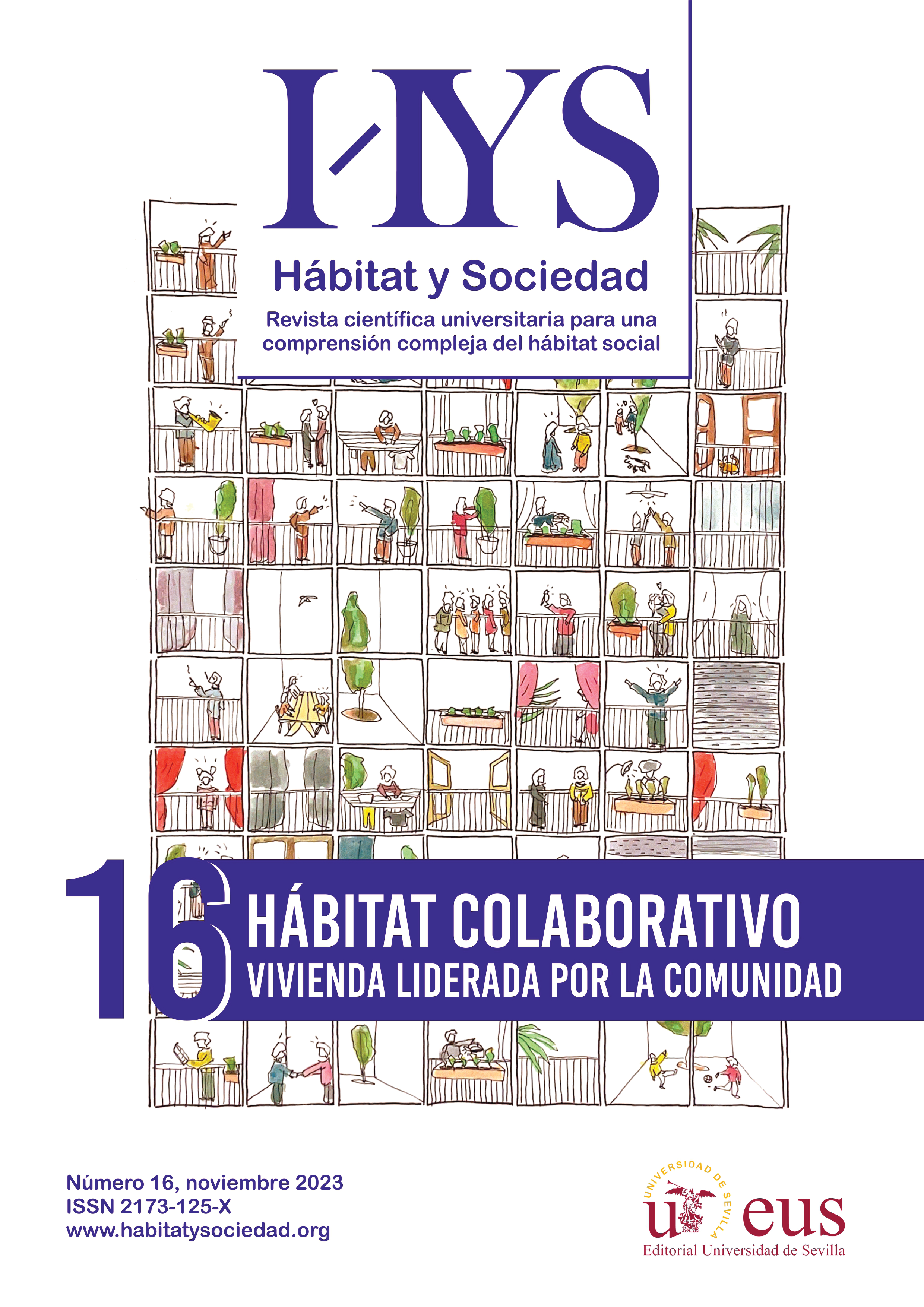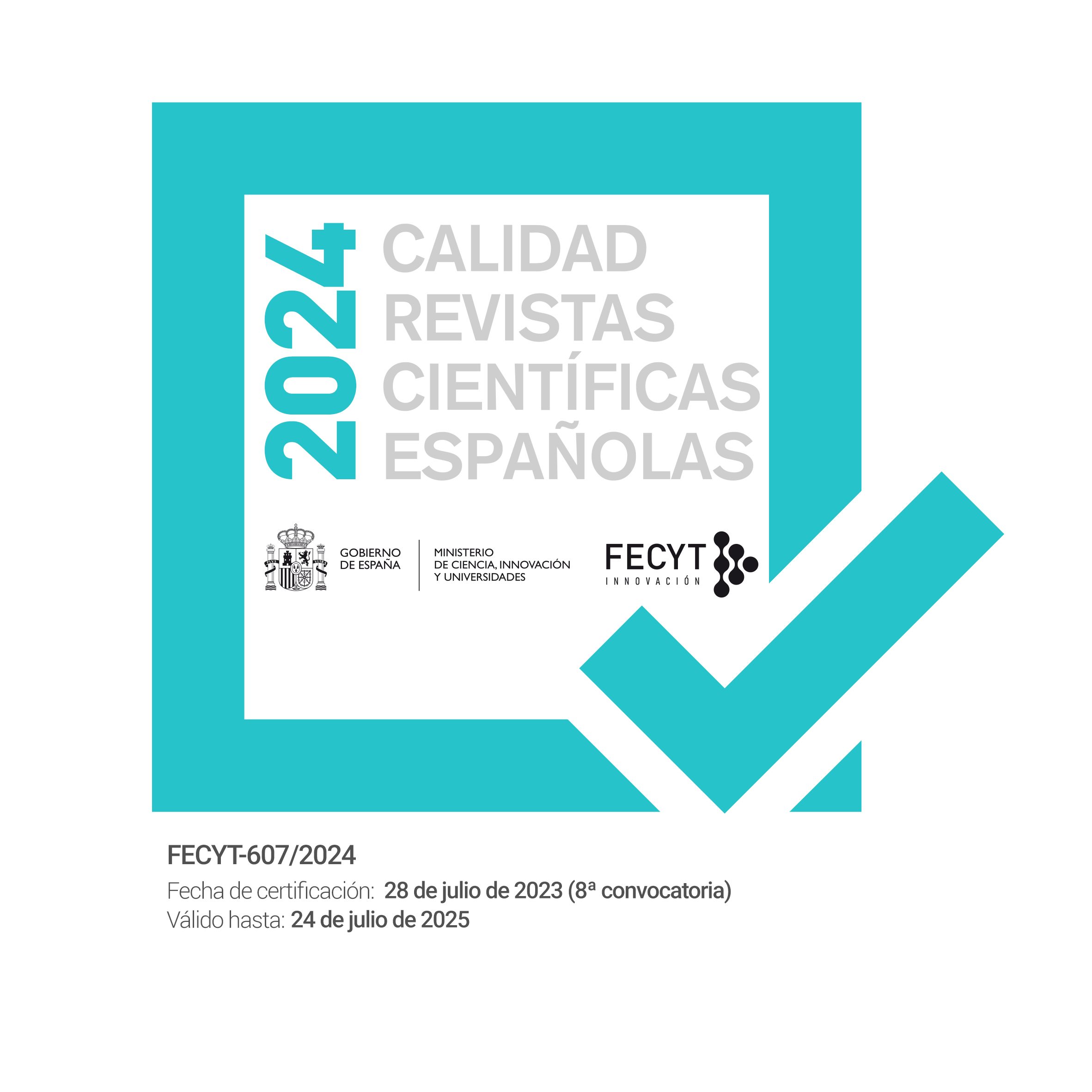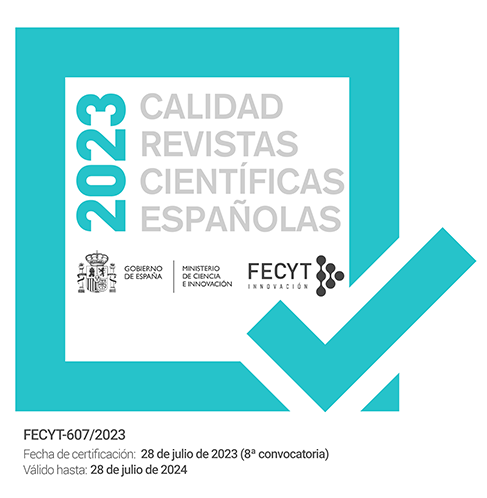Participatory design process with collectives based on the Livingston method: the case of the collaborative housing cooperative El Ciempiés
DOI:
https://doi.org/10.12795/HabitatySociedad.2023.i16.03Keywords:
participatory design, cohousing, Livingston method, cooperative, housing, COVID-19Abstract
Introduction: The purpose of this paper is to describe and analyse the first phase of the participatory design process applied to a collaborative housing project, based on the Livingston method. “El Ciempiés” cooperative decided to start a participatory process for designing its building in March 2020, coinciding with the beginning of the COVID-19 lockdown in Spain, requiring reconsideration of the techniques and tools used for the development of the project.
Method: Case study based on the analysis of documents, reports and focus groups.
Results: Description and analysis of the phases of the participatory design process of “El Ciempiés” cooperative.
Discussion: The logical order and techniques of the Livingston method supported the process, adapting its tools to the complex and changing context of the project. The central elements of the method responded to the expressed and latent demands of the collective.
Conclusions: The processes of participatory design are appropriate to the expectations and needs of the participants involved in collaborative housing projects. The Livingston method provides the bases to generate a spatial transformation strategy in self-managed processes of collaborative housing and allows it to adapt its tools to complex contexts such as working with collectives in a pandemic situation.
Downloads
References
Adianto, Joko, Gabe, Rossa Turpuk y Sihombing, Antony (2021). The failure of participatory design in the government housing provision program. International Journal of Design in Society, 15(2), 1-13. https://doi.org/10.18848/2325-1328/CGP/V15I02/1-13
Arksey, Hilary y O’Malley, Lisa (2005). Scoping studies: towards a methodological framework. International Journal of Social Research Methodology, 8(1), 19-32. https://doi.org/10.1080/1364557032000119616
Avilla-Royo, Raul, Jacoby, Sam y Bilbao, Ibon (2021). The Building as a Home: Housing Cooperatives in Barcelona. Buildings, 11(4), 137. https://doi.org/10.3390/buildings11040137
Brysch, Sara Lia y Czischke, Darinka (2022). Affordability through design: the role of building costs in collaborative housing. Housing Studies, 37(10), 1800-1820. https://doi.org/10.1080/02673037.2021.2009778
Bukovszki, Viktor, Dóci, Gabriella y Reith, András (2021). Coding Engines in Participatory Social Housing Design–A Case to Revisit Pattern Languages. Sustainability, 13(6), 3367. https://doi.org/10.3390/su13063367
Codina, Lluís (2021, 1 de septiembre). Scoping reviews: características, frameworks principales y uso en trabajos académicos. [Entrada de blog] Lluis Codina. Recuperado el 24 de abril de 2022 de: https://www.lluiscodina.com/scoping-reviews-guia/
Coller, Xavier (2005). Estudio de casos. CIS- Centro de Investigaciones Sociológicas
De Jorge-Huertas, Virginia (2020). Collaborative designing of communities: Helsinki and Zurich Pioneers. ACE: Architecture, City and Environment, 15(43). https://doi.org/10.5821/ace.15.43.9012
Detienne, Francoise, Baker, Michael y Le Bail, Chloe (2019). Ideologically-Embedded Design. EN Sebastiano Bagnara, Riccardo Tartaglia, Sara Albolino, Thomas Alexander y Yushi Fujita (eds.), Proceedings of the 20th Congress of the International Ergonomics Association (IEA 2018). IEA 2018. Advances in Intelligent Systems and Computing (vol. 822, pp. 626-630. Springer). https://doi.org/10.1007/978-3-319-96077-7_67
Devlin, Patrick, Douglas, Rachel y Reynolds, Tom (2015). Collaborative design of Older Women’s CoHousing. Working with Older People, 19(4), 188-194. https://doi.org/10.1108/WWOP-08-2015-0018
Díaz García, Vicente Javier (2008). Participación ciudadana y vivienda. El programa de autoconstrucción de la Junta de Andalucía (1988-2007) (Tesis doctoral). Universidad de Las Palmas de Gran Canaria.
El Ciempiés Sociedad Cooperativa (2021). Estatutos de El Ciempiés Sociedad Cooperativa. Recuperado el 13 de enero de 2022 de: https://elciempies.es/documentos.html
Enet, Mariana (2012). Diseño participativo: Estrategia efectiva para el mejoramiento ambiental y economía social en viviendas de baja renta. Cuadernos de Vivienda y Urbanismo, 5(10). Recuperado el 10 de diciembre de 2020 de https: //www.redalyc.org/comocitar.oa?id=629768826002
Enet, Mariana, Romero Fernández, Gustavo y Olivera Gómez, Rosa (2008). Herramientas para pensar y crear en colectivo en programas intersectoriales de hábitat. CYTED.
Etxezarreta, Aitziber, Cano, Gala y Merino, Santiago (2018). Housing cooperatives on «assignment of use»: Emerging experiences in Spain. CIRIEC-Espana, Revista de Economia Publica, Social y Cooperativa, 92, 61-86. https://doi.org/10.7203/CIRIEC-E.92.9266
Fernández Arrigoitia, Melissa y Scanlon, Kathleen (2015). Co-designing senior co-housing: the collaborative process of Featherstone Lodge. Urban Design, 136, 31-32. Recuperado el 12 de diciembre de 2022, de http://eprints.lse.ac.uk/64147/
García Pérez, Anaïs y Moya González, Luis (2018). El cohousing como una alternativa a las nuevas dinámicas de habitar en la ciudad de Madrid. Ciudad y Territorio. Estudios Territoriales, 50(195), 71-84.
Gazzoli, Rubén (2003). La otra arquitectura: los consultorios de vivienda y hábitat. Nobuko.
Hadlos, Arvin (2021). Determining the depth of households’ participation influencing the level of their residential satisfaction in a post-Haiyan resettlement. International Journal of Disaster Risk Reduction, 64, 102490. https://doi.org/10.1016/j.ijdrr.2021.102490
Hammond, Mark (2018). Spatial Agency: Creating New Opportunities for Sharing and Collaboration in Older People’s Cohousing. Urban Science, 2(3), 64. https://doi.org/10.3390/urbansci2030064
Harnecker, Marta (2005). Diseñando con los vecinos de La Manzana. EPLA.
Heslop, Julia (2021). Learning through building: participatory action research and the production of housing. Housing Studies, 36(6), 906-934. https://doi.org/10.1080/02673037.2020.1732880
Hilmer, Luisa (2020). Participatory Housing - Segal’s Self-build Method. En Del Gaudio C. et al. (Eds.), PDC ‘20: Proceedings of the 16th Participatory Design Conference 2020 - Participation(s) Otherwise (Vol. 2, pp. 68-71). Association for Computing Machinery. https://doi.org/10.1145/3384772.3385156
Livingston, Rodolfo (1990). Cirugía de casas. Nobuko.
Livingston, Rodolfo (2002). Arquitectos de la comunidad: el método. Kliczkowsky, 1ª Edición.
Lo, Tian Tian, Schnabel, Marc Aurel y Moleta, Tane (2016). Establish, exchange and engage: A support system for multiple decisions to co-produce. En Harry Timmermans (ed.), Design & Decision Support Systems in Architecture and Urban Planning, 13th International Conference on Design & Decision Support Systems in Architecture and Urban Planning, Technische Universiteit Eindhoven, The Netherlands. Recuperado el 12 de diciembre de 2022 de https://www.researchgate.net/publication/306108654
López Medina, José María (2010). Metodologías participativas para la gestión social del hábitat. Hábitat y Sociedad, 1, 83-103. https://doi.org/10.12795/rea.2017.i34.06
Martins, A. Nuno, Hobeica, Liliane y Hobeica, Adib (2021). Women-led humanitarian architecture in disaster-prone environments: Learning from the Marielle Franco Community-Design Award. International Journal of Disaster Risk Reduction, 59, 102250. https://doi.org/10.1016/j.ijdrr.2021.102250
Massad, Freddy (2020, 3 de noviembre). Entrevista a Rodolfo Livingston. [Entrada de blog] ABC Blogs. Recuperado el 27 de diciembre de 2020 de https://abcblogs.abc.es/viga-en-el-ojo/entrevistas/entrevista-a-rodolfo-livingston.html
Mota, Nelson (2019). Álvaro Siza’s Negotiated Code: Meaningful Communication and Citizens’ Participation in the Urban Renewal of The Hague (Netherlands) in the 1980s. Urban Planning, 4(3), 250-264. https://doi.org/10.17645/up.v4i3.2120
Palmer, Jasmine (2016). The Collaborative Australian Dream: self-organised urban infill housing and the potential for design disruption. En European Network of Housing Researchers Conference 2016 Conference, Belfast, Ireland. Recuperado el 12 de diciembre de 2022 de: https://www.researchgate.net/publication/301780535_The_Collaborative_Australian_Dream_self-organised_urban_infill_housing_and_the_potential_for_design_disruption
Romero, Gustavo y Mesías, Rosendo (Eds.) (2004). La participación en el diseño urbano y arquitectónico en la producción social del hábitat. CYTED.
Ruiqi, Dou (2019). Understanding Participatory Design of Public Housing Renewal in Singapore: From the Perspectives of History, Strategy and Reflection. Athens Journal of Architecture, 6, 79-96. https://doi.org/10.30958/aja.6-1-4
Socas-Wiese, Ricardo, Machado, Eneldo Fernanda y Hammerschmitt da Veiga, Alice (2021). Vivienda para estudiantes indígenas: permanencia, representatividad y proceso de proyecto participativo. Arquitecturas del Sur, 39(60), 28-47. https://doi.org/10.22320/07196466.2021.39.060.02
Sukkasame, Sadanu (2019). Collaborative Community Design Processes in Rural and Urban Settlements in Thailand. Nakhara. Journal of Environmental Design and Planning, 17, 71-80. https://doi.org/10.54028/NJ2019177180
Thompson, Matthew (2019). Dwelling on design: the influence of Logos and Eros, nouns and verbs, on public housing renewal and cooperative alternatives. En Michael E. Leary-Owhin y John P. McCarthy (Eds.), The Routledge Handbook of Henri Lefebvre, The City and Urban Society (pp. 250-259). Routledge.
Tureli, Ipek (2022). Empowerment through design? Housing cooperatives for women in Montreal. Global discourse, 12(2), 374-403. https://doi.org/10.1332/204378921X16320620457738
Valladares, Arturo (2013). The community architect program: Implementing participation-in-design to improve housing conditions in Cuba. Habitat International, 38(1), 18-24. https://doi.org/10.1016/j.habitatint.2012.09.004
Valladares, Arturo (2017). Successes and failures of participation-in-design: Cases from Old Havana, Cuba. Frontiers of Architectural Research, 6(3), 401-411. https://doi.org/10.1016/j.foar.2017.06.001
Valladares, Arturo (2014). Havana’s experience with participatory design: Towards a new method for controlling self-help housing. New Urban Configurations, 279-285. https://doi.org/10.3233/978-1-61499-365-0-285
Vázquez Cruz, Irving (2022). Familia y comunidad determinantes de la vida cotidiana en el diseño participativo de la vivienda. Academia XXII, 12(24), 117-134. https://doi.org/10.22201/fa.2007252Xp.2021.24.81590
Wang, Jingjing, Pan, Yiru y Hadjri, Karim (2018). Exploring collaborative design and sustainable living in British cohousing communities. Asian Journal of Behavioural Studies, 3(14), 30-53. https://doi.org/10.21834/ajbes.v3i14.163
Yin, Robert K. (2018). Case study research and applications: design and methods. AGE, 6ª edición.
Published
How to Cite
Issue
Section
License
Copyright (c) 2023 De los autores y Editorial Universidad de Sevilla

This work is licensed under a Creative Commons Attribution-NonCommercial-ShareAlike 4.0 International License.
Los textos publicados se considerarán propiedad intelectual de los autores y de la revista. Podrán ser usados para usos educativos y académicos, citando al autor y la publicación, con la dirección electrónica exacta. En todo caso, deberá comunicarse este tipo de uso y pedir la autorización del mismo a la dirección de la revista.
Los autores/as que publiquen en esta revista aceptan las siguientes condiciones:
- Los autores/as conservan los derechos de autor y ceden a la revista el derecho de la primera publicación, con el trabajo registrado con la licencia de atribución de Creative Commons, que permite a terceros utilizar lo publicado siempre que mencionen la autoría del trabajo y la primera publicación en esta revista.
- Los autores/as pueden realizar otros acuerdos contractuales independientes y adicionales para la distribución no exclusiva de la versión del artículo publicado en esta revista (p. ej., incluirlo en un repositorio institucional o publicarlo en un libro) siempre que indiquen claramente que el trabajo se publicó por primera vez en esta revista.
- Se permite y recomienda a los autores/as publicar su trabajo en Internet (por ejemplo en páginas institucionales o personales) antes y durante el proceso de revisión y publicación, ya que puede conducir a intercambios productivos y a una mayor y más rápida difusión del trabajo publicado (véase The Effect of Open Access).














